Last week we saw Harry Widmer took over Black Mask after Ken White left. He changed the look of the magazine, but were there changes in the content to appeal to a new audience and if so, what were they? Let’s find out by examining the January 1950 issue.
Sex appeal
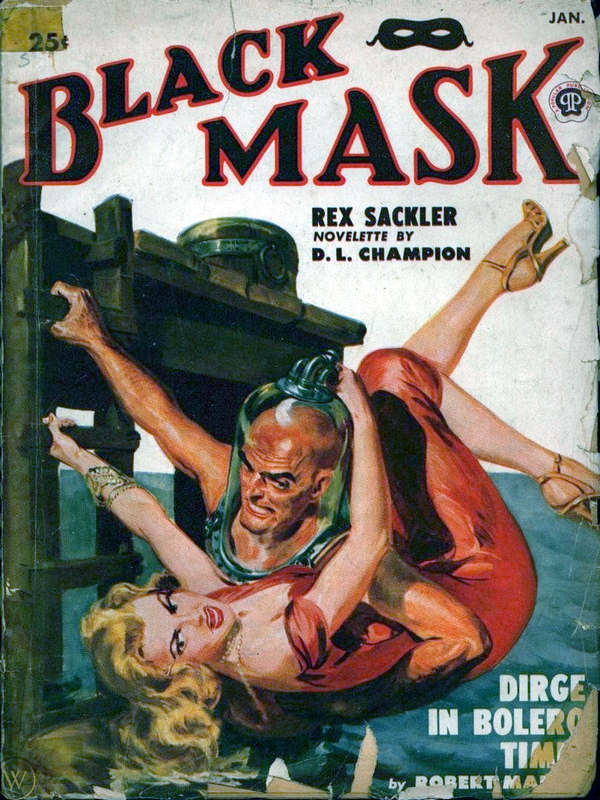
The cover harks back to the classic Black Mask era with a white background that makes the logo in black pop. Appealing to older readers, perhaps. There are changes, too. What do these covers have in common? A woman on the cover, not as a corpse, but as a participant in the action.
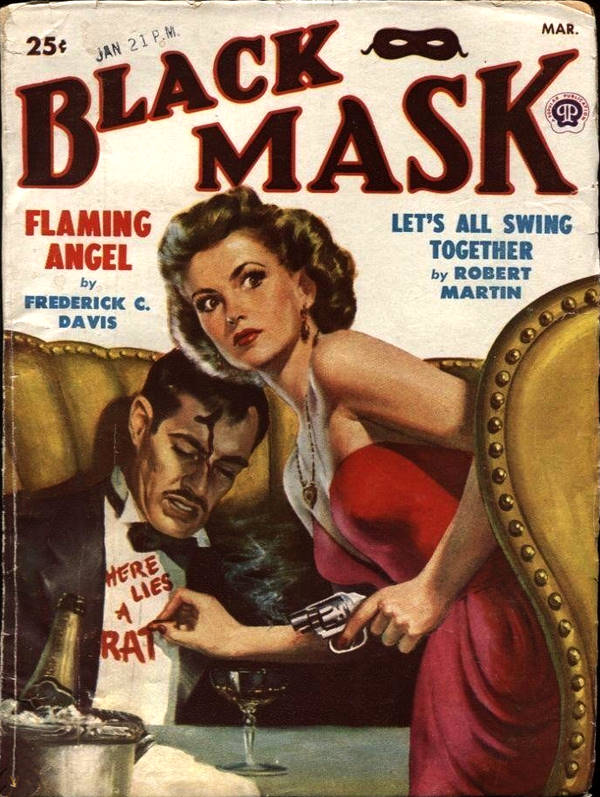
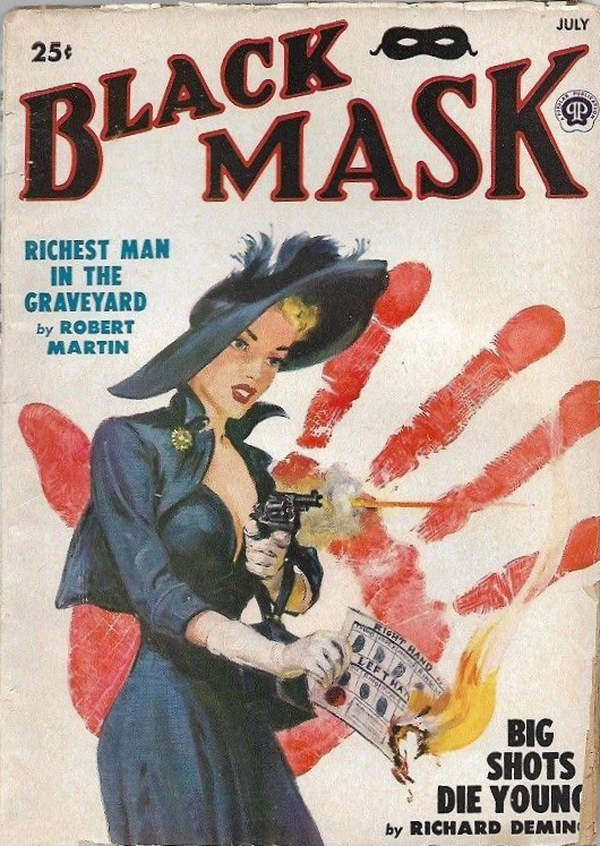
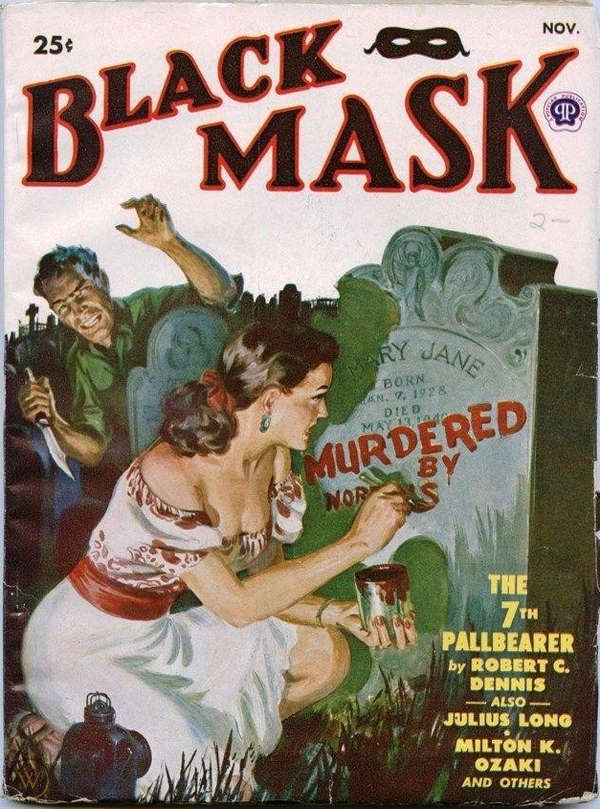
And inside? It’s the same.
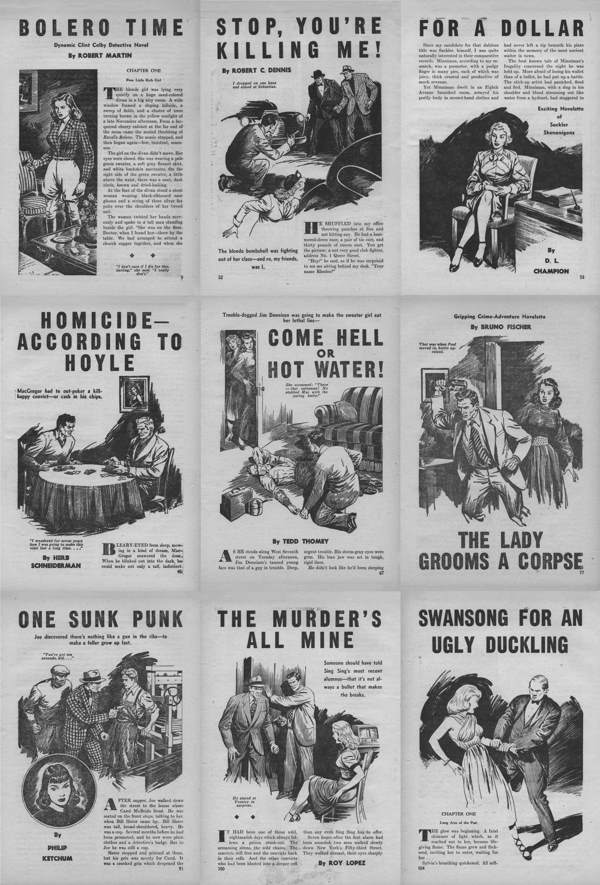
Almost every interior includes a woman. There are some that feature more than one. Was Widmer trying to appeal to a broader readership? Let’s look at the stories and find out.
Other changes
Widmer started a letter column. Reader feedback is uniformly good, praising the writers.
He also made the preview of next month’s magazine into a pictorial feature. I like it.
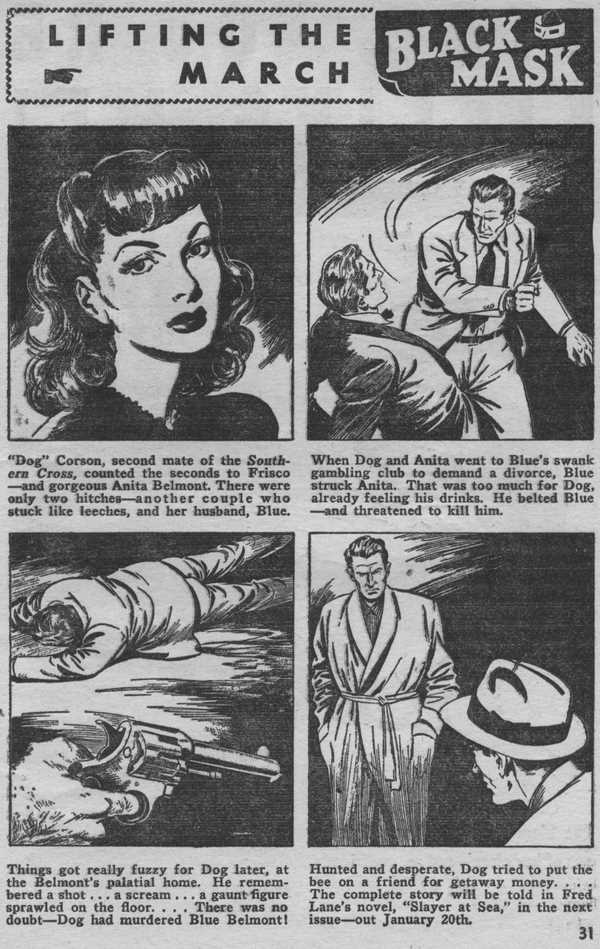
Printing moved to Cuneo Press’ Kokomo, Indiana, plant around 1950.
Dead Dames and Femme Fatales

Dirge in Bolero time features Dr. Clinton Colby, one of author Robert Martin’s recurring characters. Dr. Clinton Colby is called in to treat Mrs. Phil Eaton nee Glenda Harrow for a bullet wound. Mr. Eaton is out of town on supposedly a hunting trip, but he’s a drinker and womanizer, so who knows where he actually is. The local golf pro, an out of town man who hasn’t revealed to anyone that he’s married, is frequently seen with Glenda. Tongues wag. The pro’s wife turns up, looking to take her husband back. Phil Eaton turns up, as does his companion on the hunting trip, a woman he owes thirty thousand dollars to. Plenty of people with motivation to kill Glenda. Clinton becomes a suspect because he was an Glenda’s old boyfriend, so has to clear his own name. Martin characterizes people by their behavior rather than telling us what they are. The ending feels rushed and too neat. Readable.
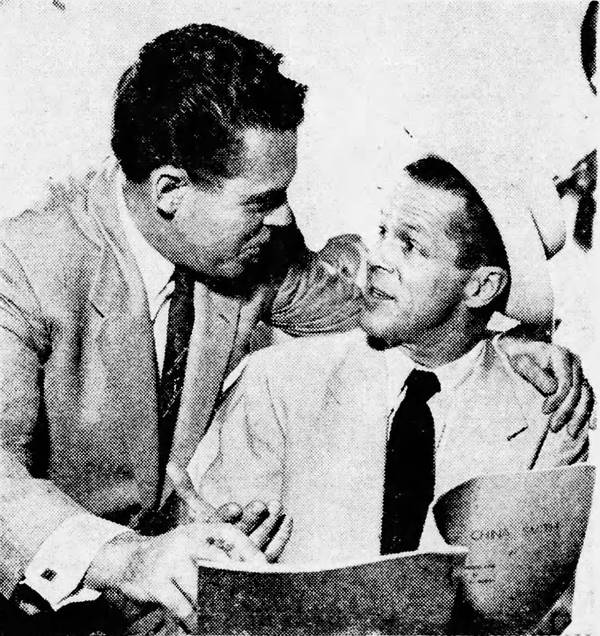
Stop, you’re killing me! by Hollywood and TV scriptwriter Robert C. Dennis has an old as the hills plot with some snappy dialog. A pro boxer, training for the championship, calls in P.I. Rhodes to keep out the riff-raff at his training camp.
The training camp was a converted farm, meaning the cows had been evicted. What had moved in was much nicer—a blonde in a sun suit and dark glasses with wide gold bands. She was sitting under an apple tree reading. A cook-book, no less. The apple tree should have warned me.
The blond is a distraction, put there by the big boss who wants to buy out the boxer’s contract after he loses. He’ll guarantee the loss by getting her to pull out just before the big fight, and has plenty of gunmen to enforce his will. No happy endings, guaranteed, unless Rhodes can find a way out. Read once for the snappy phrases.
Homicide – according to Hoyle is another old plot, but works better than the Dennis story. On a rainy night, a man comes into the house of the judge who sent him away for seven years. The man wants revenge. Herb Schneiderman, whose sole story in the pulps this was, left no trace of himself. Short and good.
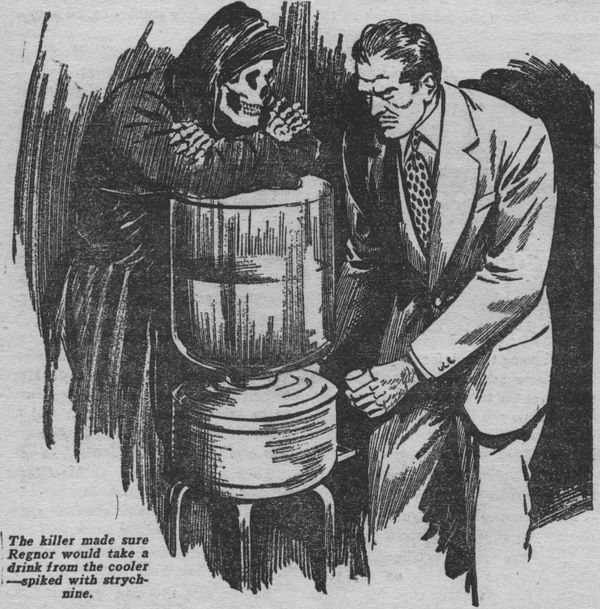
If you’ve been following this blog, you’ll know I look forward to a Rex Sackler outing. In Death for a Dollar, Sackler, the prince of penny-pinchers, almost meets his match in a client who’s reluctant to pay Sackler’s fee, even though the client is accused of murder. He tries to do Sackler out of half the fee by getting Sackler to cash a check for half the fee. No witnesses to this transaction, and Sackler gets the cash from his hoard, so no records. Sackler is stuck, or is he? Uncollected so far. Get your dose of Sackler here.
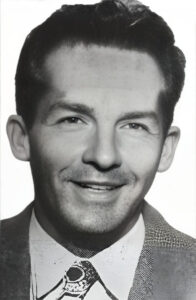
Californian Tedd Thomey (1920-2008) worked as a newsman and found time to write stories and paperback originals on the side. Then he switched to non-fiction. Come Hell or High Water! has robbery, murder and a femme fatale. It starts implausibly and quickly becomes a thrilling man on the run story, then collapses like a flat tire. A man suspected of armed robbery, on bail, decides to round up evidence that might exonerate him. This he does by going around with a salesman’s knife set in the apartment where he saw the suspect disappear, looking for suspicious activity in each flat. It’s as goofy as it sounds.

The Lady Grooms a Corpse by Bruno Fischer has a great opening. A man’s trying to commit suicide with a razor blade and failing. If that doesn’t make you curious, what will? He’s being held prisoner, whipped to unconsciousness and knows there’s more coming. Because he knows where his ex-wife is hiding, and the people holding him want to find her. An ex-wife who left him four days after their marriage and went straight for the money, becoming friendly with a gangster. Gripping all the way to the end. Recommended.
Phil Ketchum’s One Sunk Punk could have been written by Steve Fisher. Joe, the titular punk, was put on probation by a juvenile court for something he hadn’t done. The experience left him with a hatred of all policemen in general, and of Bill Slater, the neighborhood cop in particular. Joe’s girlfriend, Carol, has a brother in trouble. The brother comes to Joe for help and sucks him into aiding and abetting criminals. You know where this is going, don’t you. Salutary life lessons for Joe, a reprieve for Carol’s brother, redemption for the police and a general happy ending for all. Not recommended.
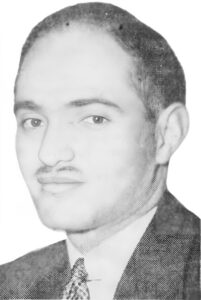
The next story is by Roy Lopez, the pseudonym of Octavus Roy Cohen Jr (1916-1974). He took the middle name of his father and the last name of his mother, Inez to make that penname. Preferring not to cash in on his father’s well-known name, Junior used the Roy Lopez pseudonym to submit stories to the sports and detective pulps and a few stories in the slick magazines, all from 1938-1955. In The Murder’s All Mine, a man breaks out of jail to get revenge on his treacherous wife and his partner, who between them framed him for a crime he didn’t commit. Superb, with a ice cold ending. This was his only story in Black Mask. What a pity.

The last story is Swansong for an Ugly Ducking by Marion O’Hearn (1903-??). O’Hearn was her real name; she was married to pulpster James Perley Hughes in the 1920s and 1930s. Her writing career lasted nearly 25 years from 1930 to 1953, mostly in the romance and western pulps. This was her second and last appearance in Black Mask.
There are echoes of Cornell Woolrich in this story of a young girl, caregiver to her bed-ridden mother. She comes into the orbit of a rich man who exerts a hypnotic power on her. Through suggestion, he manages to convey intense feeling for the girl, as well as the thought that his wife hates him and wishes him dead, literally. If that obstacle were removed…The girl has a troubled history and when the wife is found, stabbed in the chest, she’s the most likely suspect. What’s the truth? The beginning is good but the setup is too obvious. Skip it.
Home Run?

A good package, but not sure if its sufficient to make people change their tastes. Would a special promotion campaign have helped? At one point, publishers were handing out free stories/booklets to promote their magazine. If Popular was aiming at women readers, and from the evidence it does look like it, then maybe a special booklet of Black Mask enclosed in their regular magazine might have helped. But then, they’d have to spend money on this campaign. And there was no guarantee that it would work.
Harold S. Goldsmith saw the writing on the wall and sold out his stake in the company to Harry Steeger later in 1950.
Next week: Last legs
Good review of a late issue of Black Mask, Sai. As you show, even this late, the year before it ceased publication, the magazine was still very readable and of interest to collectors.
If you have this issue and read it, i’d be interested to see how your notes compare to mine.
Black Mask definitely had good stories in it right to the end. Even the reprints were good ones.
Sai, I just finished reading this issue and for the most part I enjoyed it though 5 of the stories I rated as ok but nothing special. By the way, my notes in the issue indicate that I read some of it back in the 1970’s but I reread everything this time around. The top four stories in my opinion are:
1–Stop You’re Killing Me by Robert C. Dennis. I like humorous, wise cracking PI stories written with some style. Dennis is one of my favorites and shows the influence of Chandler. VG.
2–Dirge In Bolero Time by Robert Martin. No wisecracks or humor but a good mystery with plenty of suspects. Often pulp stories don’t have enough suspects. VG.
3–Death for a Dollar by D. L. Champion. Like you, I like the Rex Sackler, penny pinching PI series. This was the last of 29 stories in the series. VG.
4–The Lady Grooms a Corpse by Bruno Fischer. Not that outstanding but good enough.
5–The other 5 stories by Thomey, Ketchum, Lopez, Schneiderman, and O’Hearn did not impress me that much but were ok.
I also like the pictorial feature and wish I knew the illustrator’s name. Two of the stories show the influence of the Ken White period during 1940-1948. He encouraged writers to write humorous and witty stories like the two tales by Ralph C. Dennis and D. L. Champion.